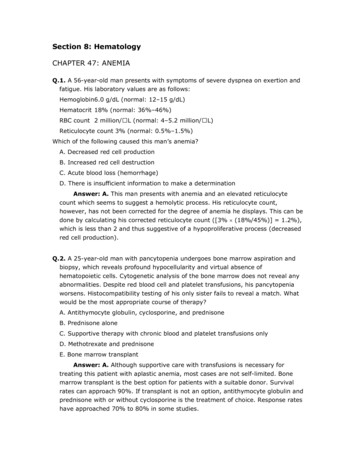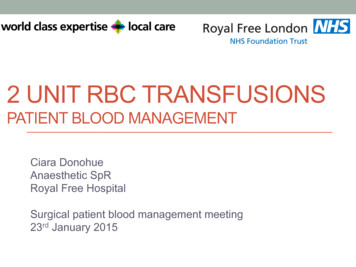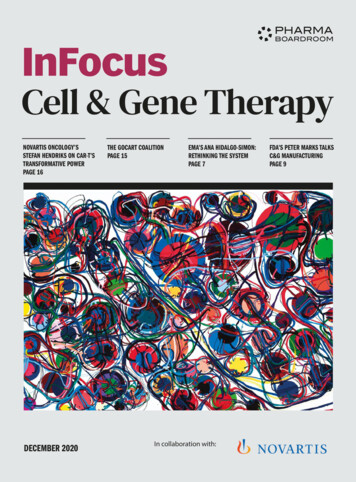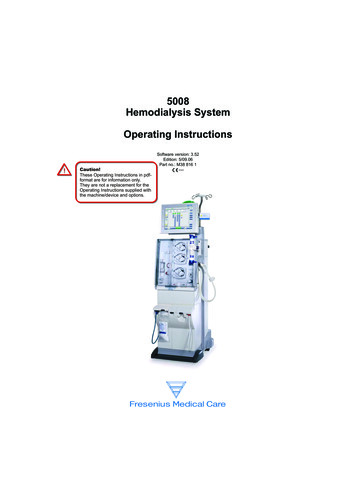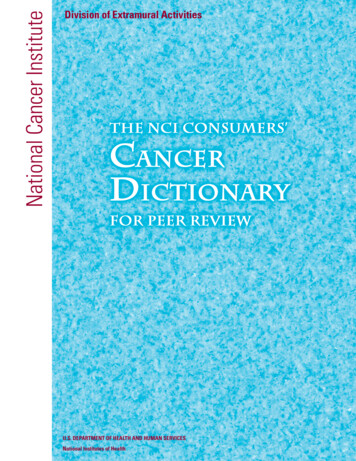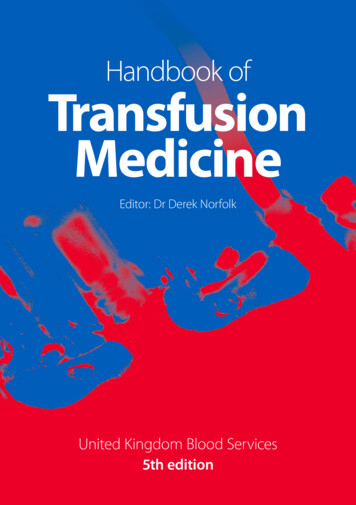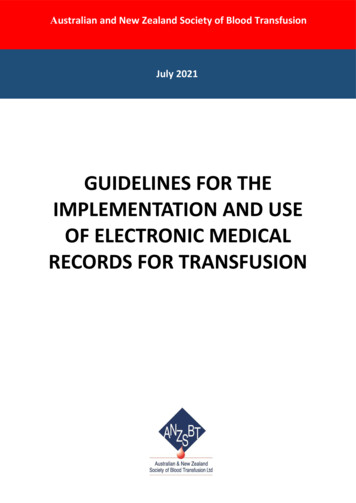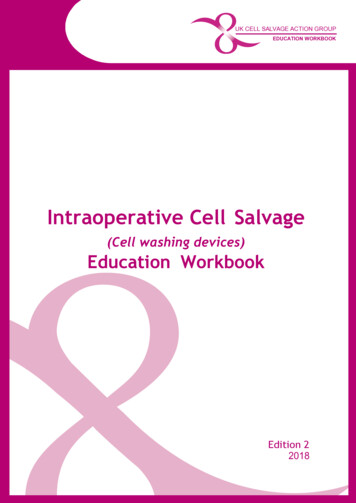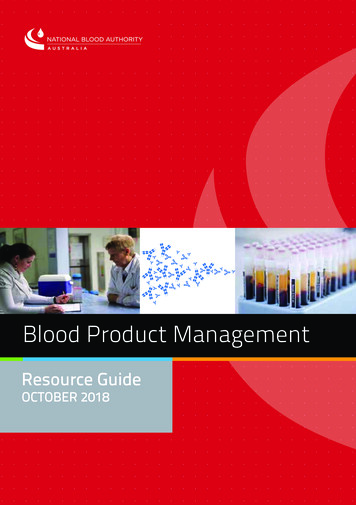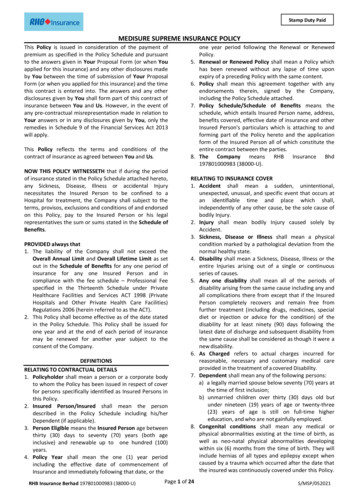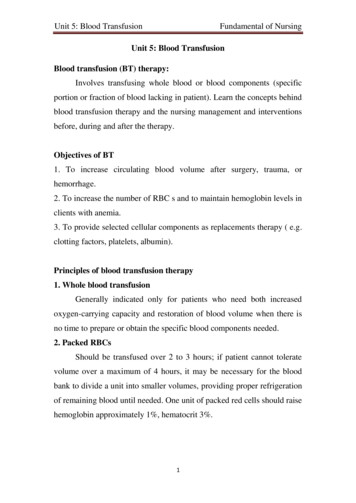
Transcription
Unit 5: Blood TransfusionFundamental of NursingUnit 5: Blood TransfusionBlood transfusion (BT) therapy:Involves transfusing whole blood or blood components (specificportion or fraction of blood lacking in patient). Learn the concepts behindblood transfusion therapy and the nursing management and interventionsbefore, during and after the therapy.Objectives of BT1. To increase circulating blood volume after surgery, trauma, orhemorrhage.2. To increase the number of RBC s and to maintain hemoglobin levels inclients with anemia.3. To provide selected cellular components as replacements therapy ( e.g.clotting factors, platelets, albumin).Principles of blood transfusion therapy1. Whole blood transfusionGenerally indicated only for patients who need both increasedoxygen-carrying capacity and restoration of blood volume when there isno time to prepare or obtain the specific blood components needed.2. Packed RBCsShould be transfused over 2 to 3 hours; if patient cannot toleratevolume over a maximum of 4 hours, it may be necessary for the bloodbank to divide a unit into smaller volumes, providing proper refrigerationof remaining blood until needed. One unit of packed red cells should raisehemoglobin approximately 1%, hematocrit 3%.1
Unit 5: Blood TransfusionFundamental of Nursing3. PlateletsAdminister as rapidly as tolerated (usually 4 units every 30 to 60minutes). Each unit of platelets should raise the recipient’s platelet countby 6000 to 10,000/mm3: however, poor incremental increases occur withall immunization from previous transfusions, bleeding, fever, infection,autoimmune destruction, and hypertension.4. GranulocytesMay be beneficial in selected population of infected, severelygranulocytopenic patients not responding to antibiotic therapy and ulocyteproduction.5. PlasmaFresh frozen plasma should be administered as rapidly as toleratedbecause coagulation factors become unstable after thawing.6. AlbuminIndicated to expand to blood volume of patients in hypovolemicshock and to elevate level of circulating albumin in patients withhypoalbuminemia.7. CryoprecipitateIndicated for treatment of hemophilia A, Von Willebrand’s disease,disseminated intravascular coagulation (DIC), and uremic bleeding.8. Factor IX concentrateIndicated for treatment of hemophilia B; carries a high risk ofhepatitis because it requires pooling from many donors.9. Factor VIII concentrateIndicated for treatment of hemophilia A; heat-treated productdecreases the risk of hepatitis and HIV transmission.2
Unit 5: Blood TransfusionFundamental of Nursing10. Prothrombin complexIndicated in congenital or acquired deficiencies of these factors.Advantages of blood component therapy1. Avoids the risk of sensitizing the patients to other blood components.2. Provides optimal therapeutic benefit while reducing risk of volumeoverload.3. Increases availability of needed blood products to larger population.Complications of Blood Transfusion1. Allergic ReactionIt is caused by sensitivity to plasma protein of donor antibody,which reacts with recipient antigen.Assess for:- Flushing- Rash, hives- Pruritus- Laryngeal edema, difficulty of breathing2. Febrile, Non-HemolyticIt is caused by hypersensitivity to donor white cells, platelets orplasma proteins. This is the most symptomatic complication of bloodtransfusionAssess for:- Sudden chills and fever- Flushing- Headache- Anxiety3
Unit 5: Blood TransfusionFundamental of Nursing3. Septic ReactionIt is caused by the transfusion of blood or componentscontaminated with bacteria.Assess for:- Rapid onset of chills- Vomiting- Marked Hypotension- High fever4. Circulatory OverloadIt is caused by administration of blood volume at a rate greater thanthe circulatory system can accommodate.Assess for:- Rise in venous pressure- Dyspnea- Crackles or rales- Distended neck vein- Cough- Elevated BP5. Hemolytic reactionIt is caused by infusion of incompatible blood products.Assess for:- Low back pain (first sign). This is due to inflammatory response ofthe kidneys to incompatible blood.- Chills- Feeling of fullness4
Unit 5: Blood TransfusionFundamental of Nursing- Tachycardia- Flushing- Tachypnea- Hypotension- Bleeding- Vascular collapse- Acute renal failureNursing Care Plan for Blood TransfusionA: Assessment findings1. Clinical manifestations of transfusions complications vary dependingon the precipitating factor.2. Signs and symptoms of hemolytic transfusion reaction include:1. Fever, Chills.2. low back pain, flank pain.3. headache4. nausea5. flushing6. tachycardia. tachypnea7. hypotension8. hemoglobinuria (cola-colored urine)B: Possible Nursing Diagnosis- Ineffective breathing pattern- Decreased Cardiac Output- Fluid Volume Deficit- Fluid Volume Excess5
Unit 5: Blood TransfusionFundamental of Nursing- Impaired Gas Exchange- Hyperthermia- Hypothermia- High Risk for Infection- High Risk for Injury- Pain- Impaired Skin Integrity- Altered Tissue Perfusion.C: Planning and Implementation1. Help prevent transfusion reaction by, verifying patient identificationbeginning with type and cross match sample collection and labeling todouble check blood product and patient identification prior to transfusion.2. Inspecting the blood product for any gas bubbles, clothing, or abnormalcolor before administration.3. Beginning transfusion slowly ( 1 to 2 mL/min) and observing thepatient closely, particularly during the first 15 minutes (severe reactionsusually manifest within 15 minutes after the start of transfusion).4. Transfusing blood within 4 hours, and changing blood tubing every 4hours to minimize the risk of bacterial growth at warm roomtemperatures.5. Preventing infectious disease transmission through careful donorscreening or performing pretest available to identify selected infectiousagents.6. Preventing hypothermia by warming blood unit to 37 C beforetransfusion.6
Unit 5: Blood TransfusionFundamental of Nursing7. On detecting any signs or symptoms of reaction:- Stop the transfusion immediately, and notify the physician.- Disconnect the transfusion set-but keep the IV line open with 0.9%saline to provide access for possible IV drug infusion.- Send the blood bag and tubing to the blood bank for repeat typingand culture.- Draw another blood sample for plasma hemoglobin, culture, andretyping.- Collect a urine sample as soon as possible for hemoglobindetermination.Nursing Interventions for ComplicationsIf blood transfusion reaction occurs:1. Stop the Transfusion Immediately.2. Start IV line (0.9% Na Cl)3. Place the client in fowler’s position if with SOB and administer O2therapy.4. The nurse remains with the client, observing signs and symptoms andmonitoring vital signs as often as every 5 minutes.5. Notify the physician immediately.6. The nurse prepares to administer emergency drugs such asantihistamines, vasopressor, fluids, and steroids as per physician’s orderor protocol.7. Obtain a urine specimen and send to the laboratory to determinepresence of hemoglobin as a result of RBC hemolysis.8. Blood container, tubing, attached label, and transfusion record aresaved and returned to the laboratory for analysis.7
Unit 5: Blood TransfusionFundamental of NursingNursing Procedure of blood transfusionThe following is a step-by-step checklist of things to do and otherresponsibilities to ensure proper blood transfusion and prevent anyunwanted reactions and errors.1. Verify the physician’s written order and make a treatment cardaccording to hospital policy.2. Observe the 10 Rs when preparing and administering any blood orblood components.3. Explain the procedure/rationale for giving blood transfusion toreassure patient and significant others and secure consent.4. Get patient histories regarding previous transfusion.5. Explain the importance of the benefits on Voluntary BloodDonation.6. Request prescribed blood/blood components from blood bank toinclude blood typing and cross matching and blood result oftransmissible Disease.7. Using a clean lined tray, get compatible blood from hospital bloodbank.8. Wrap blood bag with clean towel and keep it at room temperature.9. Have a doctor and a nurse assess patient’s condition. Countercheckthe compatible blood to be transfused against the crossmatchingsheet noting the ABO grouping and RH, serial number of eachblood unit, and expiry date with the blood bag label and otherlaboratory blood exams as required before transfusion.10.Get the baseline vital signs- BP, RR, and Temperature beforetransfusion.11.Give pre-meds 30 minutes before transfusion as prescribed.12.Do hand hygiene before and after the procedure.8
Unit 5: Blood TransfusionFundamental of Nursing13.Prepare equipment needed for BT (IV injection tray, compatibleBT set, IV catheter/ needle G 19/19, plaster, tourniquet, blood,blood components to be transfused, Plain NSS 500cc, IV set,needle gauge 18 (only if needed), IV hook, gloves, sterile 2 2gauze or transplant dressing, etc.14.If main IV fluid is with dextrose 5% initiate an IV line withappropriate IV catheter with Plain NSS on another site, anchorcatheter properly and regulate IV drops.15.Open compatible blood set aseptically and close the roller clamp.Spike blood bag carefully; fill the drip chamber at least half full;prime tubing and remove air bubbles (if any). Use needle g.18 or19 for side drip (for adults) or g.22 for pediatric (if blood is givento the Y-injection port, the gauge of the needle is disregarded).16.Transfuse the blood via the injection port and regulate at 10-15drips/min initially for the first 15 minutes of transfusion and referimmediately to the physician for any adverse reaction.17.Observe/Assess patient on an on-going basis for any untowardsigns and symptoms such as flushed skin, chills, elevatedtemperature, itchiness, urticaria, and dyspnea. If any of thesesymptoms occur, stop the transfusion, open the IV line , and reportto the doctor immediately.18.Swirl the bag gently from time to time to mix the solid with theplasma.19.Continue to observe and monitor patient post transfusion, fordelayed reaction could still occur.20.Re-check Hgb and Hct, bleeding time, serial platelet count withinspecified hours as prescribed and/or per institution’s policy.9
Unit 5: Blood TransfusionFundamental of Nursing21.Discard blood bag and BT set and sharps according to Health CareWaste Management .22.Fill-out adverse reaction sheet as per institutional policy.23.Remind the doctor about the administration of Calcium Gluconateif patient has several units of blood transfusion (3-5 more units ofblood).11
Unit 5: Blood Transfusion Fundamental of Nursing 2 3. Platelets Administer as rapidly as tolerated (usually 4 units every 30 to 60 minutes). Each unit of platelets should raise the recipient's platelet count by 6000 to 10,000/mm3: however, poor incremental increases occur with
